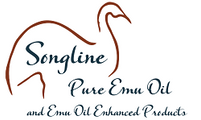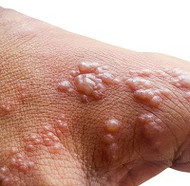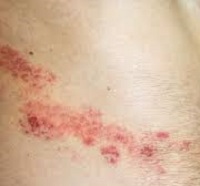Emu Oil and Viral Rashes – Monkeypox, Shingles, Chickenpox, Molluscum Contagiosum, COVID-19 and more ...
Posted by Dee Dee Mares, The Emu Lady on Oct 19, 2022
A rash is an area of irritated or swollen skin, which may appear red and inflamed on light skin while appearing purple, gray, or white on darker skin tones. Rashes are often itchy and painful and can leave scarring.
Rashes have many causes: irritants, parasites, allergies, metals, medications, anxiety and stress, bacteria, fungus, and viruses. It's essential to get an accurate diagnosis for any persistent rash. Suppose you don't know the cause of the inflammation. In that case, you may treat it incorrectly, which, at best, delays correct treatment and, at worse, may complicate your condition and result in bacterial infections and even sepsis.
The current outbreak of Monkeypox in the US is bringing more attention to viral rashes. Most viral rashes start on your trunk or face, then spread to other body parts. They can appear in many forms, such as bumps, spots, or discolorations. Some are contagious, and others are not. While most viral rashes aren't considered critical and typically heal on their own, others can be serious or be one symptom of a severe infection that can have long-term consequences.
Monkey Pox and Emu Oil
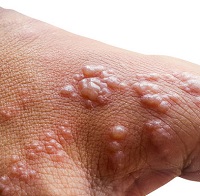
The most common symptom of Monkeypox is skin bumps like pimples quickly spreading into a rash. The rash can go through several stages, including fluid-filled blisters, open ulcers, and scabs, and be painful or itchy before healing. Other possible symptoms are fever, chills, swollen lymph nodes, exhaustion, muscle aches, backache, headache, and respiratory symptoms (e.g., sore throat, nasal congestion, or cough).
When spots or blisters dispel, the scars left may be mild or more severe. Skin discoloration is common either lighter or darker than the surrounding skin. Some people may experience keloid build-up, which is more likely to leave permanent scars. Keloid scarring occurs when your body produces an excess protein (collagen) during healing, leaving a raised and often lumpy ridge. Frequent, light applications of Pure Emu Oil to the rash as it heals will reduce the chances of keloid build-up and scarring.
If you suspect you have Monkeypox (or any viral rash), you should seek medical attention, but remember your Emu Oil products which will give you quick relief and support your medical treatments while reducing itch, pain, and scarring.
*WARNING: DuoFlex Pain Relief Cream has menthol and peppermint oil which will induce a feeling of burning on broken or thin skin – however, for some people, the warm "burn" is preferable to itch and nerve pain – proceed with caution. I used DuoFlex extensively during a Shingles infection a few years back. And yes, it did "burn," but only for a few minutes, and then the pain, itch relief, and the ability to sleep were well worth it. I would do it again. But if you aren't a masochist, I recommend Pure Emu Oil or Body Butter.
Other Common Viral Rashes
Shingles (herpes zoster)
is the same virus that causes chickenpox. The CDC estimates that 90% of those born before 1980 had chickenpox. Shingles occur when the dormant virus reactivates. One out of every three adults will contract shingles at some point in their life.
Shingles cause a painful rash that often erupts on one side of your face or body in a single stripe as it follows a nerve line. It appears as blisters that last 7-10 days until they scab over. Complete clearing of the rash can take up to four weeks, but 1 out of 10 people will develop postherpetic neuralgia – deep nerve pain that can last for months.
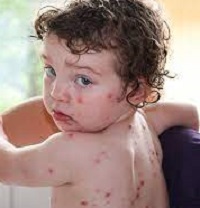
Chickenpox (varicella-zoster virus)
is a highly contagious viral infection caused by the varicella-zoster virus. It can cause itchy, fluid-filled blisters that eventually turn into scabs. The rash may first show up on the chest, back, and face, and then spread over the entire body, including inside the mouth, eyelids, or genital area, yielding 250 - 500 itchy blisters.
The chickenpox rash occurs about two weeks after exposure to the virus. Boston Children's Hospital claims over 4 million people (primarily children, but adults too) get chicken pox yearly in the US.
Just a warning, breakthrough infections can occur in adults decades after vaccination, so do not risk exposure if you can avoid it.
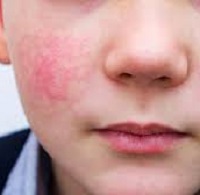
Fifth Disease (human parvovirus B19)
is one of the six most common viral rashes in children and teens and rare in infants and adults, sometimes called "slapped cheek disease" because it causes a bright red rash on the face.
The rash appears 4-14 days after infection and lasts about 5-10 days, although it can reappear several months later if a person is in the sun or their body heat rises. Some adults may experience painful joints, usually in the hands, feet, or knees.
Parvovirus B19 can cause severe anemia (a condition in which the body doesn't have enough healthy red blood cells) and may also be a factor in arthritis in adults.
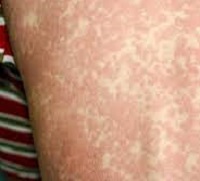
Mononucleosis (Epstein-Barr Virus)
is most common among teens ages 15 to 17 (75%), but it can affect people of all ages. After a long incubation period, symptoms such as a fever, sore throat, swollen lymph nodes, and fatigue usually lessen within a couple of weeks but can last for months and even years.
Roughly 50% will also experience a distinctive red, blotchy rash that appears on the chest and back. It's one of the most common symptoms of mono. The rash can vary in appearance from one person to another with flat pink-red spots, raised welts (hives), or Petechiae, which are tiny brown spots.
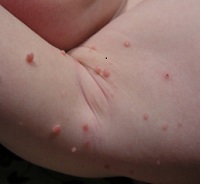
Molluscum Contagiosum (a poxvirus)
is a fairly common infection that causes a mild skin disease that primarily affects children and immunocompromised adults. It spreads through person-to-person contact and contact with infected objects.
Outbreaks can occur in different settings, like swimming pools. The rash caused by molluscum contagiosum results in the formation of lesions known as Mollusca. These lesions can appear anywhere on the body, including the face and genital areas. They are raised in appearance and can be stalk-like with an indention on the top. The rash usually clears within 6-12 months without scarring, though it can take as long as four years to disappear.
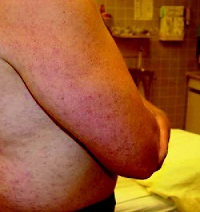
West Nile Virus (Flaviviridae virus family)
is an infection transmitted by mosquitos. This family of viruses includes Zika, Dengue, and Yellow Fever.
About 80% of infected people don't have symptoms, but 20% of those infected develop a fever with other symptoms, including body aches or rash. The rash appears 2-14 days after infection and resembles measles with both flat and raised areas.
While there is not a clear linear relationship between climate change (temperature, precipitation, humidity) and upward trends in Flaviviridae infections. It is clear that "changing climate is providing opportunities for insects and other animals to spread infectious diseases to new populations". quoted from Harvard Medical Magazine.
West Nile virus, which is now considered endemic in the United States.
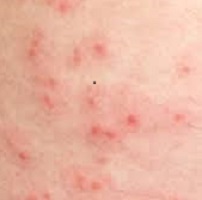
Colorado Tick Fever (Coltivirus family)
is a rare viral tick-borne infection carried by the Rocky Mountain Wood Tick, reported in Arizona, Colorado, Idaho, Montana, New Mexico, Oregon, South Dakota, Utah, and Wyoming.
Symptoms include fever, chills, headache, body aches, tiredness, sore throat, vomiting, and abdominal pain, usually appearing within 3-7 days of infection. However, it can take up to 20 days to see signs. In addition to common viral symptoms, a spotted rash occurs in 5-12% of people infected with Colorado Tick Fever.
Colorado Tick Fever is different from Rocky Mountain Spotted Fever which is also tick-borne from the Rocky Mountain Wood Tick and the American Dog Tick but is caused by bacteria. Rocky Mountain Spotted Fever can be deadly if not treated with antibiotics.

Roseola (human herpesvirus 6)
also known as Sixth Disease, is a viral infection most commonly found in children between 6 months and two years old. A roseola rash may appear 5-15 days after exposure, usually on the torso, and spreads to the arms, legs, and face. A high fever above 103°F, lasting for up to a week, can occur before the rash appears.
Adults can still be infected, especially if they didn't have roseola as a child. People with a compromised immune system may also experience a reactivated roseola infection.
Roseola treatment is pretty straightforward. It includes resting, taking anti-inflammatory medications, and making sure to drink plenty of water.
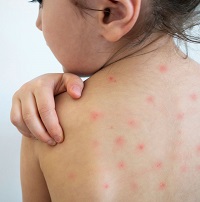
Measles (morbillivirus)
is a form of paramyxovirus that causes a viral infection that's serious for small children. Symptoms include cough, runny nose, inflamed eyes, sore throat, high fever, and a distinctive red, blotchy skin rash. It usually starts on the face as flat red blotches (later become raised) that spread down the hairline to the neck, trunk, arms, legs, and feet.
While the rash usually runs its course in about six days, it can cause severe complications for babies and children under age 5.The disease spreads through the air by respiratory droplets produced from coughing or sneezing.
The MMR vaccine prevents measles, mumps, and rubella and has made these illnesses very rare in our country.
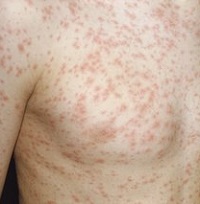
Rubella (rubella virus)
commonly called German measles is caused by a different virus but the two illnesses share some signs and symptoms, such as a red rash and swollen lymph nodes.
A rubella rash usually starts on the face as pink or light red spots and can be harder to see on darker skin but feels rough or bumpy to the touch. It spreads to form colored patches as it moves downward, away from the face.
The rash can be itchy and last up to three days. The affected skin may shed fine flakes as the rash clears.
Do not give aspirin to children with rubella, as it puts them at risk for a severe illness called Reye's syndrome. Adults can contract Rubella, but it is usually milder, however, if a pregnant woman becomes infected it can cause life-threatening complications for the unborn child.
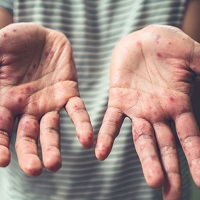
Hand, Foot, and Mouth Disease (coxsackievirus A16)
is a very contagious viral illness most common in children under five years old, but adults are susceptible to the disease and its painful symptoms, as well. This virus can spread very quickly in environments like a nursery or daycare, but also college dorms and gyms.
Symptoms start with mild fever, sore throat, runny nose, and little appetite. Then an itchy rash (flat, red spots or blisters) begins on the palms of your hands, soles of your feet, knees, elbows, genitals or butt cheeks as well as painful, blister-like mouth sores. When the blisters burst, the sores scab over and dry out, it's essential to avoid touching the blisters since the fluid and resulting scabs may contain the virus and spread the infection.
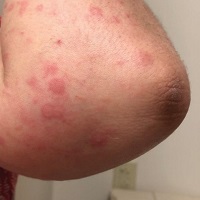
COVID-19 (coronavirus)
can cause several different rashes and skin symptoms; morbilliform rash resembling measles; urticaria which is itchy red welts; vesicles or small blisters and pseudo-chilblains also known as "COVID toes".
For images and more information, go to this Cleveland Clinic March 2022 publication:
Remember that Emu Oil and Emu Oil-based products can help relieve pain and itching, enhance healing and reduce scarring from all of these viral, and other, rashes.
Additional Sources for more reading:
https://www.cdc.gov/shingles/index.html
https://www.childrenshospital.org/conditions/chick...
https://www.cdc.gov/parvovirusb19/index.html
https://www.mayoclinic.org/diseases-conditions/mol...
https://www.ncbi.nlm.nih.gov/pmc/articles/PMC55797...
https://www.healthline.com/health/mono-rash#is-it-...
https://www.cdc.gov/hand-foot-mouth/index.html
https://www.ccjm.org/content/89/3/161
